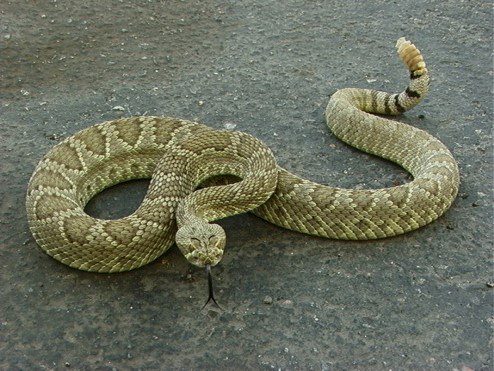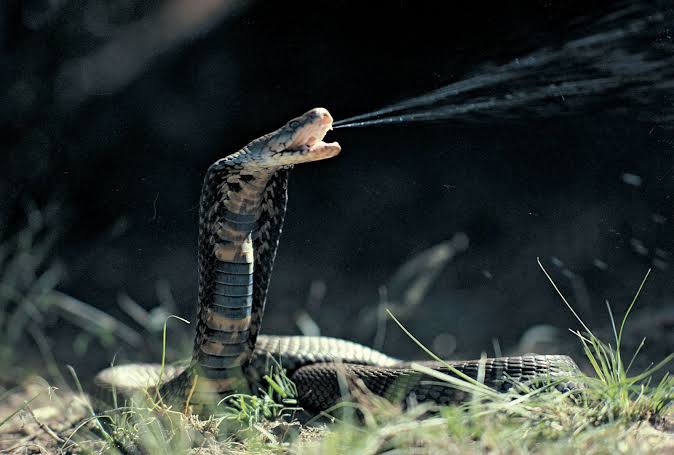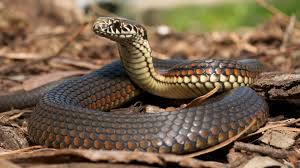Snakes (venomous snakes), scientifically known as Serpentes, are a fascinating group of reptiles that capture the attention of both scientists and enthusiasts. These creatures vary greatly in size, color, and habitat, but the venomous ones stand out due to their unique and potent defensive mechanism.
Venomous snakes possess specialized glands that produce venom, a mixture of proteins and enzymes designed for various purposes. This venom aids them in subduing prey, defending against predators, and even assisting in digestion. Among the notable venomous snake species are the Cobra (Naja), Viper (Viperidae), and Coral Snake (Micrurus).
Cobras, recognized for their iconic hood and distinctive hiss, belong to the Elapidae family. Their venom primarily targets the nervous system, leading to paralysis and, in severe cases, respiratory failure. Vipers, on the other hand, are characterized by their triangular heads and heat-sensing pits. Their venom contains potent cytotoxins that cause tissue damage and disruption of blood clotting.
The Coral Snake, a member of the Elapidae family, stands out with its colorful bands. Despite their striking appearance, they are venomous, and their neurotoxic venom affects the nervous system. Coral snakes are generally reclusive, but their venom can be potent.
Venomous snakes play crucial roles in maintaining ecological balance by controlling populations of rodents and other prey animals. However, their venom also poses risks to humans. Snakebite envenomation can lead to severe health complications and, in some cases, fatalities. Prompt medical attention is essential if bitten by a venomous snake.
In certain regions, antivenom is available to counteract the effects of snake venom. Understanding snake behavior and habitats can help reduce the risk of encountering venomous snakes. It is essential to appreciate these creatures from a safe distance and to avoid provoking them.
However, venomous snakes, with their scientific name Serpentes, bring a mix of danger and intrigue to the natural world. Their varied characteristics and potent venoms make them a subject of both scientific study and cautionary fascination. As we coexist with these remarkable reptiles, respect for their role in ecosystems and awareness of the potential dangers they pose are crucial for a harmonious relationship with nature.
Read Also: Egg Processing and Storage Methods
Animals Affected by Snakes (Serpentes)

Snakes (for venomous snakes) have a significant impact on the animals within their ecosystems, influencing both predator-prey dynamics and overall biodiversity. The presence of venomous snakes plays a vital role in shaping the behavior and characteristics of various animals.
Small mammals, such as rodents and rabbits, are particularly affected by venomous snakes. Snakes, with their venomous capabilities, act as efficient predators, helping control the populations of these smaller mammals. This regulation helps maintain a balance in the ecosystem, preventing overpopulation of certain species that could otherwise lead to ecological imbalances.
Birds are also impacted by the presence of venomous snakes, especially ground-nesting species. Snakes are known to raid nests for eggs, posing a threat to the reproductive success of bird populations. This predatory behavior influences nesting site selection and may contribute to the evolution of certain nesting behaviors in birds to avoid snake predation.
Amphibians and reptiles, which share similar habitats with venomous snakes, are part of the intricate food web affected by these predators. While some snakes feed on amphibians and reptiles, others are competitors for resources, influencing the distribution and abundance of these animals in the ecosystem.
Even larger mammals, like carnivores and ungulates, can be indirectly influenced by venomous snakes. Snakes may impact the distribution of these mammals by affecting the abundance of prey species or by influencing the behavior of potential predators.
It’s essential to note that the relationship between venomous snakes and other animals is complex and varies across different ecosystems. While snakes are crucial for controlling certain populations, their presence also demands adaptations from potential prey to avoid predation.
Additionally, the influence of venomous snakes on animals within their habitats is a multifaceted aspect of ecological dynamics. From regulating smaller mammal populations to affecting nesting behaviors of birds, the presence of venomous snakes contributes significantly to the intricate web of interactions that defines ecosystems. Understanding these relationships is key to appreciating the role of snakes in maintaining ecological balance.
Damages Caused by Snakes (venomous snakes)

Venomous snakes, while playing essential roles in ecosystem balance, can also cause damages, especially when their interactions involve humans, domestic animals, or specific economic activities. Here are some aspects of the damages caused by venomous snakes:
1. Human Health: Venomous snakebites pose a significant threat to human health. Envenomation can result in various symptoms, ranging from mild pain and swelling to severe tissue damage, paralysis, and even death in extreme cases. The impact on human health is particularly significant in regions where venomous snakes are prevalent and medical resources may be limited.
2. Livestock and Domestic Animals: Venomous snakes can pose a threat to livestock and domestic animals. Bites may cause injury, illness, or even death in animals. This can lead to economic losses for farmers and impact the livelihoods of those dependent on agriculture and animal husbandry.
3. Fear and Psychological Impact: The presence of venomous snakes can instill fear in communities. This fear can affect daily activities, outdoor work, and children’s play in areas where snakes are common. The psychological impact of living in fear of snake encounters can be long-lasting and influence the well-being of individuals and communities.
4. Agricultural Impact: In some cases, venomous snakes may be attracted to agricultural areas due to the presence of prey. This can result in disruptions to farming activities, as farmers may encounter snakes in fields or storage areas. Additionally, the predation on small mammals can indirectly affect crop protection.
5. Conservation Concerns: Misunderstandings and fear of venomous snakes can lead to unnecessary persecution and killing of these animals. In regions where certain snake species are endangered, such actions can exacerbate conservation challenges and threaten biodiversity.
6. Tourism and Recreation: In areas known for their diverse wildlife, including venomous snakes, the fear of snake encounters can impact tourism and recreational activities. Visitors may be hesitant to explore natural habitats, leading to economic consequences for local tourism industries.
In managing the damages caused by venomous snakes, it is crucial to implement strategies that balance public safety with the conservation of these important reptiles. Education and awareness programs, along with proper medical facilities and resources, can contribute to minimizing the negative impacts associated with venomous snakes while promoting coexistence with these vital components of ecosystems.
Read Also: Difference Between Poultry Vaccines and Poultry Drugs
Control and Preventive Measures

Controlling and preventing encounters with venomous snakes is crucial for ensuring human safety, protecting livestock, and maintaining a balanced ecosystem. Here are various measures that can be implemented:
1. Education and Awareness: Educating communities about the identification, behavior, and ecological importance of venomous snakes is key. This includes understanding their habitats, active times, and warning signs. Awareness programs can help people adopt cautious behaviors and reduce the risk of snake encounters.
2. Habitat Management: Modifying and managing habitats to make them less attractive to snakes and their prey can be effective. This includes minimizing potential hiding spots, such as debris piles and tall grass, around homes and agricultural areas.
3. Protective Clothing and Footwear: Encouraging the use of protective clothing, such as long pants and boots, can reduce the risk of snakebites, especially in regions where venomous snakes are common. This is particularly important for individuals working in outdoor environments.
4. Snake-Proof Fencing: Installing snake-proof fencing around homes, agricultural fields, and livestock areas can prevent snakes from entering these spaces. The fencing should be designed to prevent snakes from climbing or burrowing underneath.
5. Early Warning Systems: Developing and implementing early warning systems, especially in areas with high snake activity, can provide communities with alerts and information about snake presence. This can be particularly useful in preventing accidental encounters.
6. Professional Removal: In cases where venomous snakes are found in residential areas, professional snake removal services can be engaged. Trained experts can safely capture and relocate snakes away from populated areas.
7. Proper Waste Management: Ensuring proper waste disposal practices can help reduce the presence of rodents and other prey species that attract venomous snakes. Properly sealed bins and cleanliness can deter snakes from lingering around human habitation.
8. Community Cooperation: Encouraging communities to work together in implementing preventive measures is essential. Cooperation can include sharing information about snake sightings, promoting responsible waste management, and collectively adopting safety practices.
9. Medical Facilities and Antivenom Availability: Ensuring that medical facilities are equipped with antivenom and healthcare professionals are trained in snakebite treatment is crucial. Quick access to medical intervention can significantly reduce the severity of envenomation.
10. Conservation Efforts: Protecting the natural habitats of venomous snakes is vital for maintaining biodiversity. Conservation efforts can include preserving ecosystems, reducing habitat destruction, and minimizing human-wildlife conflict through responsible land use.
Implementing a combination of these measures tailored to specific regions and ecosystems is essential for effective control and prevention of issues related to venomous snakes. By promoting coexistence and understanding, it is possible to mitigate the risks associated with these important components of the natural world.
Frequently Asked Questions (FAQs) About Snakes (Serpentes)
1. Q: What is a venomous snake?
A: A venomous snake is a reptile that produces and injects venom into its prey or potential threats through specialized glands. The venom serves various purposes, including subduing prey and defending against predators.
2. Q: How can I identify a venomous snake?
A: Identifying venomous snakes involves recognizing specific physical features. Triangular-shaped heads, heat-sensing pits, and vertical pupils are common characteristics. However, local field guides and education programs can provide more accurate information based on regional species.
3. Q: Are all snakes dangerous?
A: No, not all snakes are dangerous. While some are venomous, the majority are non-venomous and pose no direct threat to humans. Most snakes play crucial roles in ecosystems by controlling pest populations.
4. Q: What should I do if I encounter a venomous snake?
A: Remain calm and slowly back away from the snake. Avoid sudden movements or attempting to handle the snake. Give it space to retreat, and do not provoke or corner it. Seek professional help if the snake is in a populated area.
5. Q: How can I protect my home from venomous snakes?
A: Implementing snake-proof fencing, removing potential hiding spots like debris piles, and maintaining a tidy yard can discourage snakes from entering residential areas. Seal any gaps or holes in structures that may serve as entry points.
6. Q: What should I do in case of a snakebite?
A: Seek medical attention immediately. Do not attempt to suck out the venom or use a tourniquet. Keep the affected limb immobilized and at or below heart level. Remove tight clothing or jewelry near the bite site. Call emergency services for guidance.
7. Q: Can snakes climb walls or trees?
A: Some snakes can climb walls or trees. Tree-dwelling species and those with strong muscles and scales adapted for climbing can navigate vertical surfaces. Proper fencing and habitat management can help prevent snakes from entering certain areas.
8. Q: Are baby snakes more dangerous than adults?
A: In general, baby snakes are not more dangerous than adults. However, they may lack control over the amount of venom injected during a bite, potentially delivering a higher concentration. Regardless of size, all snakebites should be treated seriously.
9. Q: Do venomous snakes intentionally attack humans?
A: Venomous snakes typically avoid humans and bite only in self-defense when they feel threatened. Most snakebites occur when people unintentionally step on or disturb snakes. Snakes prefer to avoid confrontations and will usually retreat if given the opportunity.
10. Q: Are there ways to repel snakes naturally?
A: While no foolproof natural repellent exists, certain plants like marigolds and lemongrass may act as deterrents. However, these methods have limited effectiveness. The best prevention involves habitat management, proper fencing, and education on snake behavior.
11. Q: Can antivenom treat all types of snakebites?
A: Antivenom is specific to certain snake species or groups. It is essential to identify the snake responsible for the bite to administer the correct antivenom. Seeking medical attention promptly allows healthcare professionals to determine the appropriate treatment.
Read Also: How to Grow Your Business

